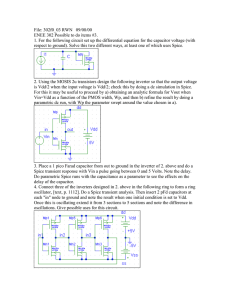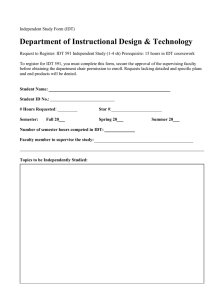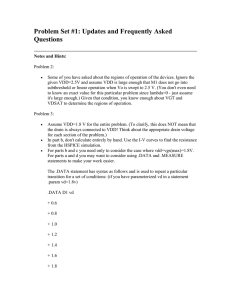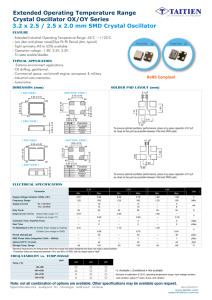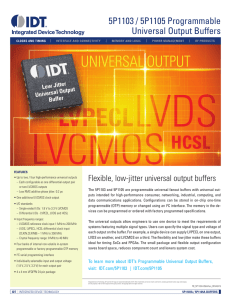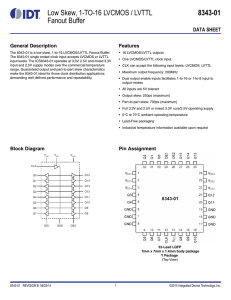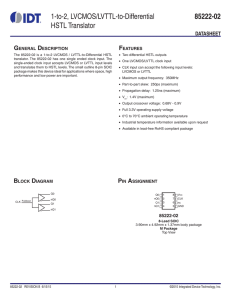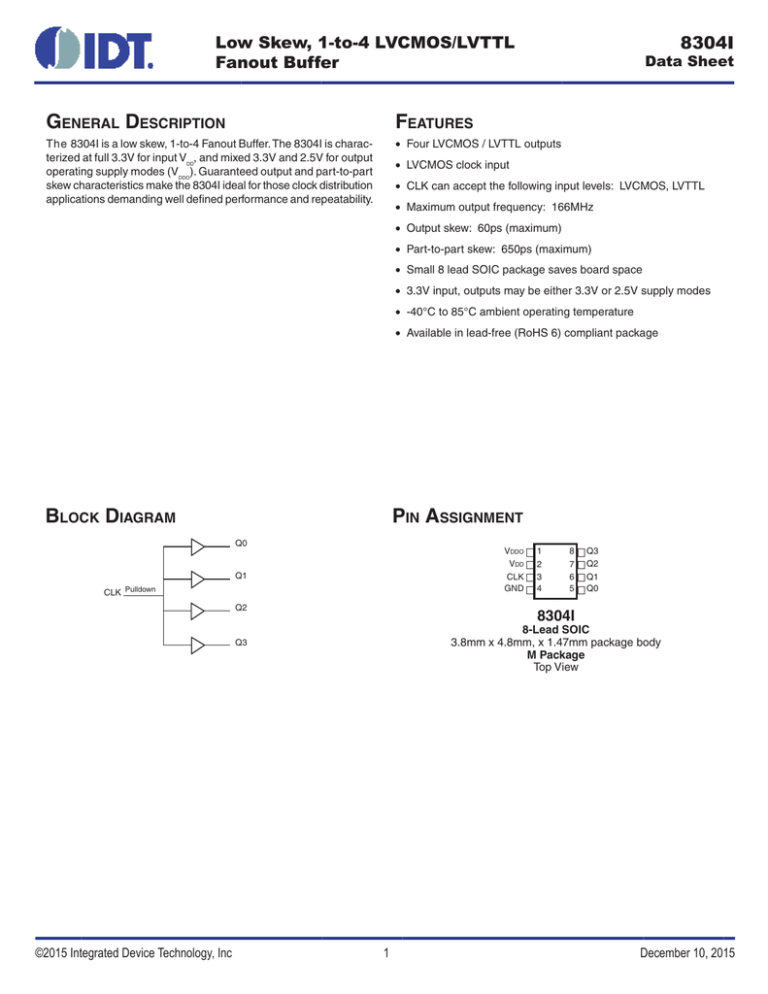
8304I
Low Skew, 1-to-4 LVCMOS/LVTTL
Fanout Buffer
Data Sheet
GENERAL DESCRIPTION
FEATURES
The 8304I is a low skew, 1-to-4 Fanout Buffer. The 8304I is characterized at full 3.3V for input VDD, and mixed 3.3V and 2.5V for output
operating supply modes (VDDO). Guaranteed output and part-to-part
skew characteristics make the 8304I ideal for those clock distribution
applications demanding well defined performance and repeatability.
• Four LVCMOS / LVTTL outputs
• LVCMOS clock input
• CLK can accept the following input levels: LVCMOS, LVTTL
• Maximum output frequency: 166MHz
• Output skew: 60ps (maximum)
• Part-to-part skew: 650ps (maximum)
• Small 8 lead SOIC package saves board space
• 3.3V input, outputs may be either 3.3V or 2.5V supply modes
• -40°C to 85°C ambient operating temperature
• Available in lead-free (RoHS 6) compliant package
BLOCK DIAGRAM
PIN ASSIGNMENT
Q0
VDDO
VDD
CLK
GND
Q1
CLK Pulldown
Q2
8
7
6
5
Q3
Q2
Q1
Q0
8304I
8-Lead SOIC
3.8mm x 4.8mm, x 1.47mm package body
M Package
Top View
Q3
©2015 Integrated Device Technology, Inc
1
2
3
4
1
December 10, 2015
8304I Data Sheet
TABLE 1. PIN DESCRIPTIONS
Number
Name
Type
Description
1
VDDO
Power
2
VDD
Power
3
CLK
Input
4
GND
Power
Power supply ground. Connect to ground.
5
Q0
Output
Single clock output. LVCMOS / LVTTL interface levels.
6
Q1
Output
Single clock output. LVCMOS / LVTTL interface levels.
7
Q2
Output
Single clock output. LVCMOS / LVTTL interface levels.
8
Q3
Output
Single clock output. LVCMOS / LVTTL interface levels.
Output supply pin. Connect to 3.3V or 2.5V.
Positive supply pin. Connect to 3.3V.
Pulldown
LVCMOS / LVTTL clock input.
NOTE: Pulldown refer to internal input resistors. See Table 2, Pin Characteristics, for typical values.
TABLE 2. PIN CHARACTERISTICS
Symbol
Parameter
CIN
Input Capacitance
CPD
Power Dissipation Capacitance
(per output)
RPULLDOWN
Input Pulldown Resistor
51
kΩ
ROUT
Output Impedance
7
Ω
©2015 Integrated Device Technology, Inc
Test Conditions
V ,V
DD
DDO
Minimum
Typical
= 3.465V
2
Maximum
Units
4
pF
15
pF
December 10, 2015
8304I Data Sheet
ABSOLUTE MAXIMUM RATINGS
Supply Voltage, VDD
4.6V
Inputs, VI
-0.5V to VDD + 0.5 V
Outputs, VO
-0.5V to VDDO + 0.5V
Package Thermal Impedance, θJA
112.7°C/W (0 lfpm)
Storage Temperature, TSTG
-65°C to 150°C
N OT E : S t r e s s e s b eyo n d t h o s e l i s t e d u n d e r A b s o l u t e
Maximum Ratings may cause permanent damage to the
device. These ratings are stress specifications only. Functional
operation of product at these conditions or any conditions beyond
those listed in the DC Characteristics or AC Characteristics is not
implied. Exposure to absolute maximum rating conditions for extended periods may affect product reliability.
TABLE 3A. POWER SUPPLY DC CHARACTERISTICS, VDD = VDDO = 3.3V±5%, TA = -40°C TO 85°C
Symbol
Parameter
Test Conditions
Minimum
Typical
Maximum
Units
VDD
Power Supply Voltage
3.135
3.3
3.465
V
VDDO
Output Power Supply Voltage
3.135
3.3
3.465
V
IDD
Power Supply Current
18
mA
IDDO
Output Supply Current
11
mA
TABLE 3B. POWER SUPPLY DC CHARACTERISTICS, VDD = 3.3V±5%, VDDO = 2.5V±5%, TA = -40°C TO 85°C
Symbol
Parameter
VDD
VDDO
IDD
IDDO
Test Conditions
Minimum
Typical
Maximum
Units
Positive Supply Voltage
3.135
3.3
3.465
V
Output Supply Voltage
2.375
2.5
2.625
V
Power Supply Current
18
mA
Output Supply Current
11
mA
TABLE 3C. LVCMOS / LVTTL DC CHARACTERISTICS, VDD = VDDO = 3.3V±5%, TA = -40°C TO 85°C
Symbol
Parameter
VIH
Input High Voltage
VIL
Input Low Voltage
IIH
Input High Current
VDD = VIN = 3.465V
IIL
Input Low Current
VDD = 3.465V, VIN = 0V
-5
µA
Refer to NOTE 1
2.6
V
IOH = -16mA
2.9
V
IOH = -100uA
3
V
VOH
VOL
Test Conditions
Output High Voltage
Output Low Voltage
Minimum
Typical
Maximum
Units
2
VDD + 0.3
V
-0.3
1.3
V
150
µA
Refer to NOTE 1
0.5
V
IOL = 16mA
0.25
V
IOL = 100uA
0.15
V
NOTE 1: Outputs terminated with 50Ω to VDDO/2. See Parameter Measurement Section, “3.3V Output Load Test Circuit”.
Ω
©2015 Integrated Device Technology, Inc
3
December 10, 2015
8304I Data Sheet
TABLE 3D. LVCMOS / LVTTL DC CHARACTERISTICS, VDD = 3.3V±5%, VDDO = 2.5V±5%, TA = -40°C TO 85°C
Symbol
Parameter
Test Conditions
VIH
Input High Voltage
VIL
Input Low Voltage
IIH
Input High Current
VDD = VIN = 3.465V
IIL
Input Low Current
VDD = 3.465V, VIN = 0V
VOH
Output High Voltage; NOTE 1
VOL
Output Low Voltage; NOTE 1
Minimum
Typical
Maximum
Units
2
VDD + 0.3
V
-0.3
1.3
V
150
µA
-5
µA
2.1
V
0.5
V
NOTE 1: Outputs terminated with 50Ω to VDDO/2. See Parameter Measurement Section, “3.3V/2.5V Output Load Test Circuit”.
ΩΩΩ
TABLE 4A. AC CHARACTERISTICS, VDD = VDDO = 3.3V±5%, TA = -40°C TO 85°C
Symbol
Parameter
Test Conditions
Minimum
fMAX
Output Frequency
tpLH
Propagation Delay,
Low-to-High; NOTE 1
tjit
Buffer Additive Phase Jitter, RMS;
refer to Additive Phase Jitter Section
tsk(o)
Output Skew; NOTE 2, 4
tsk(pp)
Part-to-Part Skew; NOTE 3, 4
tR
Output Rise Time
30% to 70%
250
tF
Output Fall Time
30% to 70%
odc
Output Duty Cycle
ƒ ≤ 166MHz
Typical
2
125MHz,
Integration Range
12kHz – 20MHz
Maximum
Units
166
MHz
3.3
ns
0.17
ƒ = 133MHz
ps
50
ps
600
ps
500
ps
250
500
ps
40
60
%
NOTE: Electrical parameters are guaranteed over the specified ambient operating temperature range, which is established
when the device is mounted in a test socket with maintained transverse airflow greater than 500 lfpm. The device will meet
specifications after thermal equilibrium has been reached under these conditions.
NOTE: All parameters measured at 166MHz unless noted otherwise.
NOTE 1: Measured from VDD/2 of the input to VDDO/2 of the output.
NOTE 2: Defined as skew between outputs at the same supply voltage and with equal load conditions.
Measured at VDDO/2.
NOTE 3: Defined as skew between outputs on different devices operating at the same supply voltages
and with equal load conditions. Using the same type of inputs on each device, the outputs are measured
at VDDO/2.
NOTE 4: This parameter is defined in accordance with JEDEC Standard 65.
©2015 Integrated Device Technology, Inc
4
December 10, 2015
8304I Data Sheet
TABLE 4B. AC CHARACTERISTICS, VDD = 3.3V±5%, VDDO = 2.5V±5%, TA = -40°C TO 85°C
Symbol
Parameter
Test Conditions
Minimum
2.3
Typical
Maximum
Units
166
MHz
3.7
ns
60
ps
fMAX
Output Frequency
tpLH
Propagation Delay, Low-to-High; NOTE 1
ƒ ≤ 166MHz
tsk(o)
Output Skew; NOTE 2, 4
ƒ = 133MHz
tsk(pp)
Part-to-Part Skew; NOTE 3, 4
650
ps
tR
Output Rise Time
30% to 70%
250
500
ps
tF
Output Fall Time
30% to 70%
250
500
ps
odc
Output Duty Cycle
40
60
%
NOTE: Electrical parameters are guaranteed over the specified ambient operating temperature range, which is established
when the device is mounted in a test socket with maintained transverse airflow greater than 500 lfpm. The device will meet
specifications after thermal equilibrium has been reached under these conditions.
All parameters measured at 166MHz unless noted otherwise.
NOTE 1: Measured from VDD/2 of the input to VDDO/2 of the output.
NOTE 2: Defined as skew between outputs at the same supply voltage and with equal load conditions.
Measured at VDDO/2.
NOTE 3: Defined as skew between outputs on different devices operating at the same supply voltages
and with equal load conditions. Using the same type of inputs on each device, the outputs are measured
at VDDO/2.
NOTE 4: This parameter is defined in accordance with JEDEC Standard 65.
©2015 Integrated Device Technology, Inc
5
December 10, 2015
8304I Data Sheet
ADDITIVE PHASE JITTER
(dBm) or a ratio of the power in the 1Hz band to the power in the
fundamental. When the required offset is specified, the phase noise
is called a dBc value, which simply means dBm at a specified offset
from the fundamental. By investigating jitter in the frequency domain,
we get a better understanding of its effects on the desired application
over the entire time record of the signal. It is mathematically possible
to calculate an expected bit error rate given a phase noise plot.
The spectral purity in a band at a specific offset from the fundamental
compared to the power of the fundamental is called the dBc Phase
Noise. This value is normally expressed using a Phase noise plot
and is most often the specified plot in many applications. Phase
noise is defined as the ratio of the noise power present in a 1Hz
band at a specified offset from the fundamental frequency to the
power value of the fundamental. This ratio is expressed in decibels
Additive Phase Jitter @
125MHz (12kHz to 20MHz) = 0.17ps typical
This is illustrated above. The device meets the noise floor of what
is shown, but can actually be lower. The phase noise is dependent
on the input source and measurement equipment.
As with most timing specifications, phase noise measurements has
issues relating to the limitations of the equipment. Often the noise
floor of the equipment is higher than the noise floor of the device.
©2015 Integrated Device Technology, Inc
6
December 10, 2015
8304I Data Sheet
PARAMETER MEASUREMENT INFORMATION
3.3V OUTPUT LOAD AC TEST CIRCUIT
2.5V OUTPUT LOAD AC TEST CIRCUIT
OUTPUT SKEW
PART-TO-PART SKEW
OUTPUT RISE/FALL TIME
OUTPUT DUTY CYCLE/PULSE WIDTH/PERIOD
PROPAGATION DELAY
©2015 Integrated Device Technology, Inc
7
December 10, 2015
8304I Data Sheet
RELIABILITY INFORMATION
TABLE 5. θJAVS. AIR FLOW TABLE
θJA by Velocity (Linear Feet per Minute)
0
Single-Layer PCB, JEDEC Standard Test Boards
Multi-Layer PCB, JEDEC Standard Test Boards
153.3°C/W
112.7°C/W
200
500
128.5°C/W
103.3°C/W
115.5°C/W
97.1°C/W
NOTE: Most modern PCB designs use multi-layered boards. The data in the second row pertains to most designs.
TRANSISTOR COUNT
The transistor count for 8304I is: 416
PACKAGE OUTLINE AND DIMENSIONS
PACKAGE OUTLINE - SUFFIX M FOR 8 LEAD SOIC
TABLE 6. PACKAGE DIMENSIONS - SUFFIX M
SYMBOL
Millimeters
MINIMUN
N
MAXIMUM
8
A
1.35
1.75
A1
0.10
0.25
B
0.33
0.51
C
0.19
0.25
D
4.80
5.00
E
3.80
4.00
e
1.27 BASIC
H
5.80
6.20
h
0.25
0.50
L
0.40
1.27
α
0°
8°
Reference Document: JEDEC Publication 95, MS-012
©2015 Integrated Device Technology, Inc
8
December 10, 2015
8304I Data Sheet
TABLE 7. ORDERING INFORMATION
Part/Order Number
Marking
Package
Shipping Packaging
Temperature
8304AMILF
8304AMIL
8 lead “Lead Free” SOIC
Tube
-40°C to +85°C
8304AMILFT
8304AMIL
8 lead “Lead Free” SOIC
Tape and Reel
-40°C to +85°C
©2015 Integrated Device Technology, Inc
9
December 10, 2015
8304I Data Sheet
REVISION HISTORY SHEET
Rev
B
B
Table
Page
3B
3
LVCMOS/LVTTL DC Characteristics Table, added IOH and IOL Test Conditions
to VOH and VOL rows.
T7
1
8
Features Section - added lead-free bullet.
Ordering Information Table - added lead-free part number, marking and note.
Updated datasheet format.
3.3V AC Characteristics Table - added Buffer Additive Phase Jitter spec.
Added Buffer Additive Phase Jitter Plot.
Ordering Information - Deleted “ICS” from the Part/Order number column.
Pin Assignment - corrected “pullup” label to “pulldown” label.
Pin Description Table - deleted pullup from note.
Pin Characteristics Table - deleted Rpullup row.
T4A
T1
T2
4
6
9
1
2
2
T7
9
C
T7
D
D
Description of Change
Removed ICS in the part numbers.
Removed LF note at the bottom of the Ordering Information table.
Removed the quantity of 2500 from the Tape & Reel in the Ordering information
table.
Updated datasheet header and footer.
©2015 Integrated Device Technology, Inc
10
Date
4/4/02
11/09/06
2/11/09
10/29/10
12/10/15
December 10, 2015
8304I Data Sheet
Corporate Headquarters
6024 Silver Creek Valley Road
San Jose, CA 95138 USA
www.IDT.com
Sales
1-800-345-7015 or 408-284-8200
Fax: 408-284-2775
www.IDT.com/go/sales
Tech Support
www.idt.com/go/support
DISCLAIMER Integrated Device Technology, Inc. (IDT) reserves the right to modify the products and/or specifications described herein at any time, without notice, at IDT's sole discretion. Performance specifications and
operating parameters of the described products are determined in an independent state and are not guaranteed to perform the same way when installed in customer products. The information contained herein is provided
without representation or warranty of any kind, whether express or implied, including, but not limited to, the suitability of IDT's products for any particular purpose, an implied warranty of merchantability, or non-infringement of the intellectual property rights of others. This document is presented only as a guide and does not convey any license under intellectual property rights of IDT or any third parties.
IDT's products are not intended for use in applications involving extreme environmental conditions or in life support systems or similar devices where the failure or malfunction of an IDT product can be reasonably expected to significantly affect the health or safety of users. Anyone using an IDT product in such a manner does so at their own risk, absent an express, written agreement by IDT.
Integrated Device Technology, IDT and the IDT logo are trademarks or registered trademarks of IDT and its subsidiaries in the United States and other countries. Other trademarks used herein are the property of IDT or
their respective third party owners.
For datasheet type definitions and a glossary of common terms, visit www.idt.com/go/glossary.
Copyright ©2015 Integrated Device Technology, Inc. All rights reserved.



